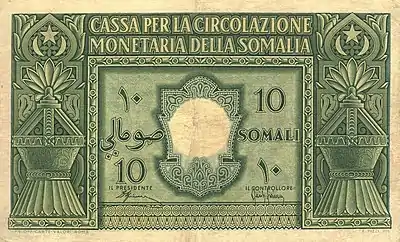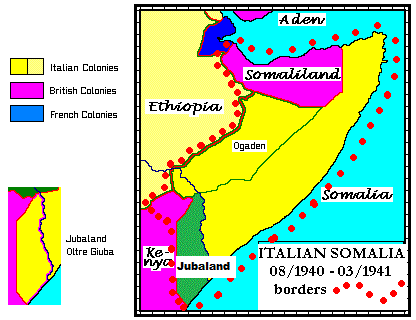Italian language of Somalia
The Italian language of Somalia was an official language of Somalia. It was used for nearly one century during intermittent periods of time, from the end of the XIX century until the early 2010s.

History
Italian was the main official language in Italian Somaliland, called officially Somalia italiana, from the end of the XIX century until February 1947.
Following the acquisition of Jubaland by Italy in 1924, the Jubaland region -south of the "Somalia italiana"- maintained English at a semi-official status for some years thereafter until the late 1920s, but in 1940 only the Italian was used and spoken by native Somalis [1]
Italian was the mother tongue of the Italian settlers of Somalia. The Somalian school system in the colonial era before WW2 was in Italian language and limited mainly to primary schools and a few middle schools -like the "Scuola Regina Elena"(), but in the capital Mogadishu of "Italian Somalia" there was an important high school.[2] In this Lyceum was created in the early 1950s the "National Institute of Legal, Economic and Social Studies", as a post-secondary school in Italian language for pre-university studies in order to access the Italian universities.[3]
In the late 1940s the Italian language was still spoken fluently by nearly 15% of the native Somalis and was practically understood by all the inhabitants of former Italian Somalia. Additionally it is noteworthy to pinpoint that -according to historian Tripodi[4]- in the area most developed of Italian Somalia (the triangle Mogadishu-Merca-Villabruzzi), the Italian was spoken by nearly one third of the native population as a second language at the end of 1941 (when the Allies conquered all Italian Somalia). Furthermore, the main newspaper of Mogadishu during the Italian Trusteeship of Somalia -under ONU mandate- was the "Corriere di Mogadiscio", written in Italian until the early 1960s.[5]
There was also the existence of a pidgin Italian in the Mogadishu area during the 1950s, 1960s and 1970s, according to academic Mauro Tosco.[6]
A pidginized Italian of Somalia?Banti (1990) is probably the only existing analysis of Italian as spoken in Somalia based upon a corpus of actual sentences. Banti's corpus was very small and drawn from two speakers only, namely, two Somali women employed as house workers by Italian expatriates in the eighties.........A simplified and unstable form of Italian very probably continued to be in use among uneducated Somali when entering in contact with the Italian community. It is also possible that its use was actually boosted in the seventies and eighties: formal education in Italian was no longer available, while the number of educated Somali of the older generations (often speaking “good” Italian) and of Italian residents (many of them with a certain command of Somali) was slowly decreasing. At the same time, there was a burgeoning number of Italian expatriates working in technical cooperation and education, many of them spending relatively short periods of time in the country.......Certainly the points in common between this "simplified Italian of Somalia" and the "Restructured Italian Pidgin of Eritrea" are striking: is there a common origin? This seems to be the answer adumbrated by Banti, who hints at a "common tradition” rather than to "parallel developments”, without further elaboration. One can hypothesize that the Eritrean troops deployed to Somalia by the Italian authorities during the colonial times may have acted as middlemen in the acquisition of a modicum of Italian on the part of Somalis, especially in Mogadishu. Mauro Tosco[7]
During the United Nations Trusteeship period from 1949 until 1960, Italian along with Somali were used at an official level internally, whilst the UN's main working language of English was the language used during diplomatic, international and occasionally for economic correspondence.[8]
After 1960 independence, the Italian remained official for another nine years. During those years in the capital Mogadishu 2/3 of the population was bilingual and/or able to understand the Italian language.
Italian was later declared an official language again by the Transitional Federal Government along with English in 2004,[9] but only for a few years.
Only a few older Somalis speak and/or understand the Italian, mainly in Mogadishu. But more than three hundred loanwords from the Italian language are usually present in the Somalian language.
Main Italian loanwords in Somalian language
Nearly one thousand Italian words are "loanworded" in the actual Somalian language (including those who are from English, but are originated from Italian during the Middle Ages in England -like "bankiga" (from italian "banco"; 'bank' in english) and "Konto" (from Italian "Conto"; 'account' in english).
For example, all the month names are clearly from Italian:
Italian/Somalian
- Gennaio/Janaayo..............Luglio/Luuliyo
- Febbraio/Febraayo............Agosto/Agoosto
- Marzo/Maarso..................Settembre/Sebteembar
- Aprile/Abriil.......................Ottobre/Oktoobar
- Maggio/Maajo...................Novembre/Nofeembar
- Giugno/Juun.....................DicembreDiseembar
The following are some of the 300 most common Italian loanwords:
Somalian - Italian (English)
- Boorso – Borsa (bag)
- Goono – Gonna (skirt)
- Baasta - Pasta (pasta)
- Jalaato – Gelato (ice cream)
- Katiinad – Cateena (chain)
- Rajastiin/rajabeeto – reggiseno/reggipetto (bra)
- Foorno – Forno (oven)
- Torcia (torch)
- Okayaalo – Occhiali (glasses)
- Konto - Conto (account)
- Kooba diin – Comodino (night table)
- Katabaan – Attaccapanni (coat hanger)
- Armaajo – Armadio(wardrobe)
- Suugo – Sugo (sauce)
- Doorshe Doolshe – Dolce (cake)
- Fargeeto – Forchetta (fork)
- Fiilo – Filo (cord)
- Farmajo - Formaggio (cheese)
- Jaalo – Giallo (yellow)
- Shukumaan - asciugamano (towel)
- Taako – Tacco (heels)
Notes
- Blaha, David Ryan. Pushing Marginalization: British Colonial Policy, Somali Identity, and the Gosha'Other'in Jubaland Province, 1895 to 1925. Diss. Virginia Tech, 2011.
- Italian Mogadishu (Mogadiscio italiano)
- https://books.google.com/books?id=DPwOsOcNy5YC&pg=PR33&lpg=PR33&dq=National+Institute+of+Legal,+Economic+and+Social+Studies+in+1954+mogadishu&source=bl&ots=mP42GvAq5x&sig=yOpgFHBoJy27ENMYV3us-68jnJ4&hl=it&sa=X&ved=0ahUKEwjOgafixZ_bAhUILKwKHc4RB3MQ6AEITTAF#v=onepage&q=National%20Institute%20of%20Legal%2C%20Economic%20and%20Social%20Studies%20in%201954%20mogadishu&f=false
- Tripodi, Paolo. "The Colonial Legacy in Somalia". Second chapter
- Corriere di Mogadiscio's first page of 05/15/1955 ()
- M. Tosco. "A case of weak Romancisation: Italian in East Africa" (http://www.maurotosco.net/ewExternalFiles/TOSCO_2008_Italian%20in%20East%20Africa.pdf)
- Tosco, Mauro. "A case of weak Romancisation: Italian in East Africa" p. 392
- Strangio, Donatella. "The Somali People: Between Trusteeship and Independence." The Reasons for Underdevelopment. Physica, Heidelberg, 2012. 1-37.
- According to article 7 of Transitional Federal Charter for the Somali Republic: The official languages of the Somali Republic shall be Somali (Maay and Maxaatiri) and Arabic. The second languages of the Transitional Federal Government shall be English and Italian.
Bibliography
- Banti, Giorgio. L'italiano parlato da Somali a Mogadiscio. Franco Angeli editore. Milano, 1990
- Tosco, Mauro. A case of weak Romancisation: Italian East Africa. Somalia section. Monton De Gruyer editor. New York, 2010
- Tripodi, Paolo. The Colonial Legacy in Somalia. St. Martin's P Inc. New York, 1999.
